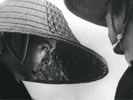Eye For Film >> Movies >> Sword Of Doom (1966) Film Review
It’s Spring 1860, feudal Japan. An old man and his granddaughter are labouring over Mount Mitake towards Edo. When they stop to rest at a shrine, the man privately prays to die so that he may relieve the girl of the burden he is to her. Softly a lone swordsman approaches and summarily slices into the old man, granting his wish. It is a stunningly framed, cold sequence that sets the brutal tone of Kihachi Okamoto’s Sword Of Doom, a tone that can only become darker as events build to their climax.
We learn that the swordsman is Ryunosuke, a deadly samurai renowned for both the cruelty of his sword and person, much to the shame of his ailing father. This is soon exemplified when the wife of his next intended victim, a challenger in an exhibition match, comes to plead clemency for her husband. Not only does Ryunosuke demand she surrender her chastity to him, he then slays her partner anyway with a spectacularly swift single strike.

As time passes on Ryunosuke shows that his sword skills are more than an expression of technical prowess; they represent a forging of his mind, his personality, with the metal in his hands. “The sword is the soul,” says a revered samurai instructor, “study the soul to study the sword. An evil mind, an evil sword.” What becomes disturbing is the ease and near-psychosis with which Ryunosuke sets about his killing. He appears amoral in his actions and only truly animated by slaughtering or cruelly subjugating the women in his life.
He is a dark, troubled character stalking through the unsettled times, slowly portrayed as a tortured, unhappy man who has no place in his world any more. Ultimately events catch up with him and the film climaxes with Ryunosuke becoming the sole target of an almighty, literally hellish onslaught, which he almost welcomes with tragic glee.
His enigmatic and doomed journey is brilliantly played by the dark, brooding and menacing Tatsuya Nakadai. His Ryunosuke is a formidable, threatening screen presence that perfectly suits Kihachi Okamoto’s ‘samurai noir’ style. Way back in 1966 the director created a film of exceptional power and beauty, with panning landscapes, intense close ups and inventive angles combined with a masterful command of broodingly lit and shaded cinematography. Frequently he creates scenes of exceptional genius that are a joy to savour. Particularly exceptional are the pulsating, intimidating watermill scenes and later the slightly arthouse use of the traditional Japanese paper partitions as cinematic projection screens.
The choreographed regular sword fights, from one-on-one encounters to ambushes and sustained attacks, are fantastic. They are visceral, gruesome action sequences that more than stand up to comparison with more modern escapades for compelling virtuosity and gritty realism. With Woo-esque and Kill Bill tendencies apparent, to name but two, subsequent films owe many a debt.
Beyond the psycho-dynamics of the Ryunosuke character (Has his fighting style corrupted him? Has his nature maligned his skills?), the film is set during a time of political change and upheaval in Japan’s feudal system and this social unrest and concern chimes with Kihachi Okamoto’s contemporary Sixties sensibilities. Japan had been reeling from its bloodily devastating conflicts for some time and a new social consciousness was starting to emerge, coming to terms with a traditional cultural heritage within or at odds with an evolving modernity, a struggle that Ryunosuke’s tortured brutality and isolation could be seen express.
Overall, a great film, worthy of the title ‘classic’.
Reviewed on: 15 Nov 2006



















